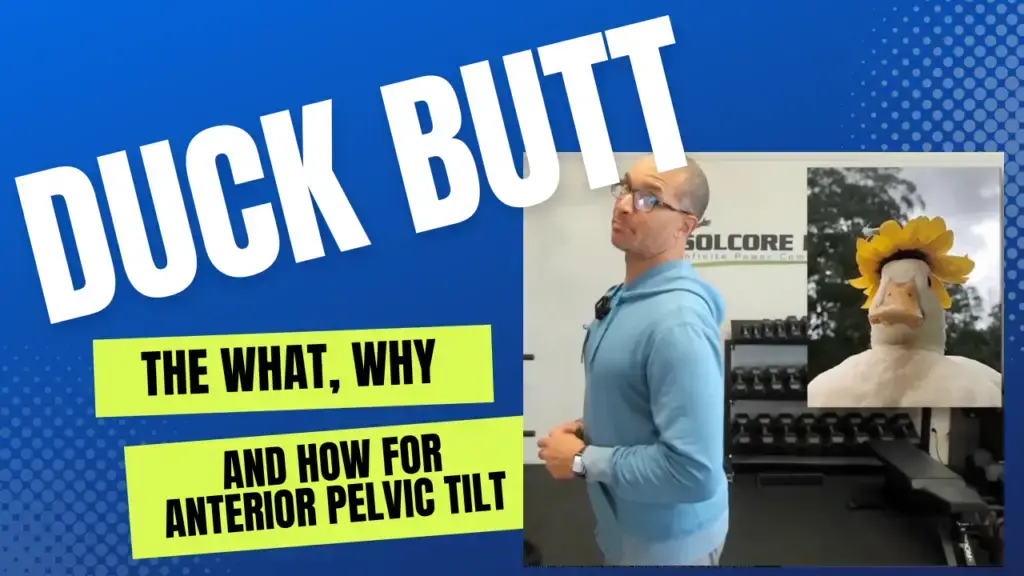“Duck butt” might sound funny, but anterior pelvic tilt is no joke.
It’s a common postural issue where your pelvis tilts too far forward—and it’s one of the main reasons people suffer from chronic lower back pain, disc bulges, SI joint instability, and more.
I’m Ekemba Sooh, SomaTherapist and SomaTrainer. I had anterior pelvic tilt myself—and it played a major role in my L4-L5 disc bulge and sciatic pain. No trainer, therapist, or doctor ever told me the tilt was the root cause.
They were treating symptoms. Not the source.

Click on the image to watch
What Is Anterior Pelvic Tilt?
Your pelvis naturally tilts slightly forward to support upright movement. But anterior pelvic tilt happens when this angle becomes exaggerated and stuck—creating a “duck butt” posture.
This tilt disrupts your body’s alignment and sets the stage for chronic compensation patterns. Over time, these compensations become permanent dysfunctions.
How It Becomes a Problem
Your body is a biotensegrity structure—meaning it’s designed to distribute force efficiently across the entire system. If one area tightens or weakens, your body adjusts to keep you moving. That’s compensation.
Compensation isn’t bad at first. But if left unchecked, it snowballs into bigger problems:
- Chronic lower back pain
- Lumbar disc issues (bulges, herniations, stenosis)
- SI joint dysfunction
- Pelvic floor and organ dysfunction
- Reduced performance and poor energy transfer
It all stems from the inability to attenuate force efficiently—because the structure is compromised.
What Causes Anterior Pelvic Tilt?
Too much sitting is a big culprit. It shortens the hip flexors (especially the psoas) and weakens the posterior chain (glutes, hamstrings, spinal stabilizers).
Over time, your body learns this dysfunctional position—and your nervous system adopts it as your default.
For some, it’s even genetic. But genetics just mean you have to be more intentional—not that you’re doomed.
Why Most Approaches Fail
Typical solutions focus on isolated muscles. But your body doesn’t work in isolation—it moves as an integrated system through fascia.
That’s why general exercise, yoga, and stretching routines often fail. You feel good temporarily, but your body snaps right back to the same pattern the next day.
Why? Because you didn’t train the fascia to support a new pattern.
The Real Solution: Train Fascia + Function
To fix anterior pelvic tilt, you need to retrain your entire structure:
- Stretch the shortened hip flexors (especially the psoas)
- Strengthen the weakened glutes, hamstrings, and back muscles
- Activate fascia chains, not just muscles, to build intelligent, whole-body control
The best tools I’ve found for this are osteopathic-based etiology exercises—like the ELDOA and my full training system. These methods respect how the body actually works: as a connected, intelligent, adaptable structure.
When to Start? Now.
If you’re in your 20s or 30s—start now and prevent future issues.
If you’re in your 40s, 50s, or 60s—and already feeling pain—this needs to be your primary focus.
You can’t afford to ignore anterior pelvic tilt. It’s not just a posture issue—it’s a performance killer, a pain amplifier, and a hidden driver of long-term health problems.
What to Do Next
If this resonates, here are a few ways to go deeper:
- 📘 Download my free eBook – Get Out of Pain, Get Mobile & Live the Life of Your Dreams
- 📅 Book a consultation – Personalized support and a plan tailored to your body
Final Thought
Anterior pelvic tilt is a structural dysfunction—but it’s also an opportunity.
It’s your body’s way of asking for smarter input. When you respond with the right training, you’ll not only relieve pain—you’ll become stronger, more mobile, and more connected to your body than ever before.
Don’t wait until things break down. Train holistically. Train intelligently. Train to support the life you want to live..
Building a foundation for a better life.
Find out more @

Leave a Reply